Megaforce
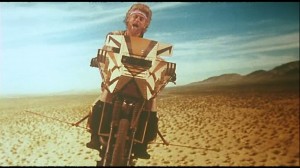 The initial financial failure of Disney’s Tron (directed by Steven Lisberger) was attributed to the enormous expectations based on the egregious expense of the project because of the complicated computer effects. Tron was simplistic story-wise, and the replication of the feel of a video game would become commonplace not long after its 1982 release. The $20 million had been spent on the technological advances which ironically succeeded in developing a following for a video game based on the movie. There were several versions of the game; one had the player in the film’s colored lightcycles*, trying to avoid the other bikes on the screen.
The initial financial failure of Disney’s Tron (directed by Steven Lisberger) was attributed to the enormous expectations based on the egregious expense of the project because of the complicated computer effects. Tron was simplistic story-wise, and the replication of the feel of a video game would become commonplace not long after its 1982 release. The $20 million had been spent on the technological advances which ironically succeeded in developing a following for a video game based on the movie. There were several versions of the game; one had the player in the film’s colored lightcycles*, trying to avoid the other bikes on the screen.
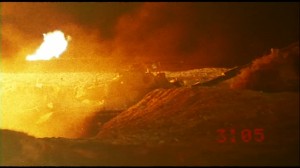 The colored motorcycles resemble an image from another $20 million sci-fi film from 1982, Hal Needham’s Megaforce, where real life motorcycles emit colored smoke behind them. And that’s pretty much where Megaforce’s visual creativity ends which makes the financial expenditure rather mysterious. Tron and Megaforce both owe a lot to Star Wars, both were clearly envisioned in sci-fi western terms, but Megaforce is far more interested in explosions, car stunts, and gunfire than actual ingenuity. That’s because Needham, who appears to be represented in Megaforce as Michael Beck’s** redneck character (though Needham has a cameo himself), was a stuntman who used his connections as the guy who lived in Burt Reynolds’ poolhouse to develop into a film director.
The colored motorcycles resemble an image from another $20 million sci-fi film from 1982, Hal Needham’s Megaforce, where real life motorcycles emit colored smoke behind them. And that’s pretty much where Megaforce’s visual creativity ends which makes the financial expenditure rather mysterious. Tron and Megaforce both owe a lot to Star Wars, both were clearly envisioned in sci-fi western terms, but Megaforce is far more interested in explosions, car stunts, and gunfire than actual ingenuity. That’s because Needham, who appears to be represented in Megaforce as Michael Beck’s** redneck character (though Needham has a cameo himself), was a stuntman who used his connections as the guy who lived in Burt Reynolds’ poolhouse to develop into a film director.
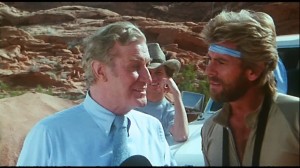 Needham’s most famous films were the first two Smokey and the Bandit films, and to a lesser extent, the first two Cannonball Run films (the third is called Speed Zone) and it was this momentum that got Needham the Megaforce job. Other factors probably had to with Jackie Chan, who Megaforce producer Raymond Chow forced on Needham when he was making the Cannonball Run films, in an effort to make Chan a star in America too. In Hong Kong it worked, as Chan was top-billed (as opposed to 10th billed in the US), but Chan wouldn’t break through until 1996’s Rumble in the Bronx.
Needham’s most famous films were the first two Smokey and the Bandit films, and to a lesser extent, the first two Cannonball Run films (the third is called Speed Zone) and it was this momentum that got Needham the Megaforce job. Other factors probably had to with Jackie Chan, who Megaforce producer Raymond Chow forced on Needham when he was making the Cannonball Run films, in an effort to make Chan a star in America too. In Hong Kong it worked, as Chan was top-billed (as opposed to 10th billed in the US), but Chan wouldn’t break through until 1996’s Rumble in the Bronx.
Now Chan is not in Megaforce, it’s difficult to imagine him in any role apart from the token Asian among the cast of cornpone warriors, played by Evan Kim, who also played Bruce Lee in the Enter the Dragon parody in The Kentucky Fried Movie. No, Needham was more interested in pure white-bread jingoism; hence the villains in Megaforce are all Communist stereotypes or vague foreigners with Spanish accents, like lead henchman Henry Silva. Barry Bostwick is the ethnically cleansed Ace Hunter, sporting a blue headband and perfectly coiffed blond hair, and his compatriots are all juvenile males, but honorable to a fault. That’s why when Edward Mulhare (in a role eerily similar to the one he had in Knight Rider, which premiered later that same year) asks for help from the Megaforce*** to goad Silva and his troops into crossing into Mulhare’s country’s territory so they can attack, Mulhare is the one who ends up as the bad guy. He has ulterior motives, and nothing underhanded can be accepted in Megaforce. How do we know that? Why, when the Megaforce attacks a base they give themselves four minutes to get in and out and Needham makes sure we’re aware of this by literally having a clock on screen the entire time, counting down. The Megaforce can’t spare a second, and they don’t think the enemy will ever fire back, delaying them.
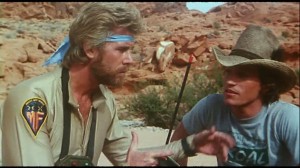 These sorts of mild bits of macho aren’t why Megaforce has a cult following though, going as far as to clearly inspire Team America: World Police, with several sequences even duplicated. No, that has to do with the rampant homoerotic costuming (from the costumers of Batman and Robin) and the absolute pointlessness of what appears on screen. The Megaforce wear motorcycle helmets with arrows painted on them, arrows that seem to be pointing at the brains they don’t have.
These sorts of mild bits of macho aren’t why Megaforce has a cult following though, going as far as to clearly inspire Team America: World Police, with several sequences even duplicated. No, that has to do with the rampant homoerotic costuming (from the costumers of Batman and Robin) and the absolute pointlessness of what appears on screen. The Megaforce wear motorcycle helmets with arrows painted on them, arrows that seem to be pointing at the brains they don’t have.
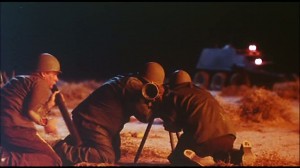 This lack of awareness comes full center in scenes like one where Ace Hunter lets Major Zara (played by Indian beauty queen Persis Khambatta, from Star Trek: The Motion Picture) know that no matter how proficient she is at military games, she can’t come with them to fight Silva and his gang because it would upset the team’s morale, or some such nonsense. Her response to the decision? “That’s what makes you what you are, a great leader.” Their romance is based on such respect, or that’s all we can believe, because when they embrace in the next scene as if they were longtime lovers, there’s either 15 minutes of development missing or Needham didn’t think women had a choice in who they would fall in love with and why.
This lack of awareness comes full center in scenes like one where Ace Hunter lets Major Zara (played by Indian beauty queen Persis Khambatta, from Star Trek: The Motion Picture) know that no matter how proficient she is at military games, she can’t come with them to fight Silva and his gang because it would upset the team’s morale, or some such nonsense. Her response to the decision? “That’s what makes you what you are, a great leader.” Their romance is based on such respect, or that’s all we can believe, because when they embrace in the next scene as if they were longtime lovers, there’s either 15 minutes of development missing or Needham didn’t think women had a choice in who they would fall in love with and why.
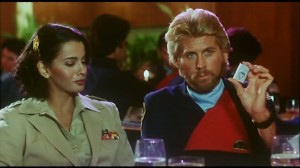 Despite an early scene where we learn that women don’t like cartoon pigs, I’m going with the deleted scenes option, because Megaforce is such a mess structurally and pacingwise. Bostwick doesn’t appear for the first 15 minutes and he’s the hero. Silva is in one or two shots in the opening scene and then we don’t see him for 45 minutes. The movie appears to be set in the future, but Ace Hunter has a very important putdown on Silva, “The good guys win, even in the ‘80s.” I guess that explains the electronic score Megaforce has, but a time period rarely seems relevant to the proceedings. Besides, you don’t want to pretend your movie is set in the future when they appear to use balloons made out of stone for target practice.
Despite an early scene where we learn that women don’t like cartoon pigs, I’m going with the deleted scenes option, because Megaforce is such a mess structurally and pacingwise. Bostwick doesn’t appear for the first 15 minutes and he’s the hero. Silva is in one or two shots in the opening scene and then we don’t see him for 45 minutes. The movie appears to be set in the future, but Ace Hunter has a very important putdown on Silva, “The good guys win, even in the ‘80s.” I guess that explains the electronic score Megaforce has, but a time period rarely seems relevant to the proceedings. Besides, you don’t want to pretend your movie is set in the future when they appear to use balloons made out of stone for target practice.
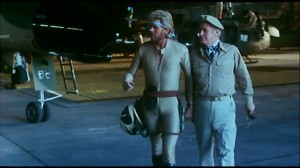 One can only speculate where the money went (up their nose?), because it certainly isn’t in the shoddy miniatures, or the fantastically abysmal blue-screen work that isn’t the least bit convincing (using the already antiquated Introvision process, also used by Knight Rider). Maybe all the money went to a wrangler for Bostwick’s headband?
One can only speculate where the money went (up their nose?), because it certainly isn’t in the shoddy miniatures, or the fantastically abysmal blue-screen work that isn’t the least bit convincing (using the already antiquated Introvision process, also used by Knight Rider). Maybe all the money went to a wrangler for Bostwick’s headband?
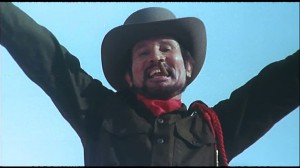 * Ok, it was really just moving lines on the screen, but you could easily imagine yourself in the lightcycle.
* Ok, it was really just moving lines on the screen, but you could easily imagine yourself in the lightcycle.
** In an odd twist, Beck was the lead in another 1982 war movie, Battletruck, where he played a character named Hunter.
*** The Megaforce is an elite group of military stragglers from armies all over the world, presumed dead or missing. Or at least that’s what the hilarious opening crawl says, read to us in the utmost of seriousness. A crawl only slightly shorter and more convoluted than the legendary one that opens Uwe Boll’s Alone in the Dark.
P.S. Enjoy the theme from Megaforce.



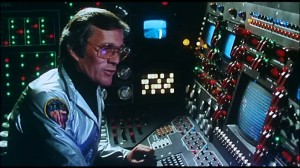

Maria T. Kelly says:
July 6th, 2017
10:16 pm
I just had a weird thought. Do you think that Megaforce is in some strange way a really bad Classic Mission: Impossible spoof?